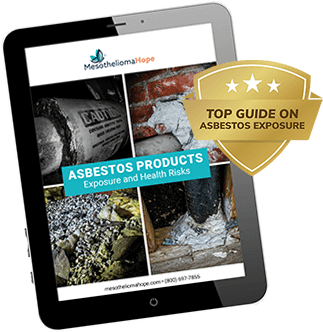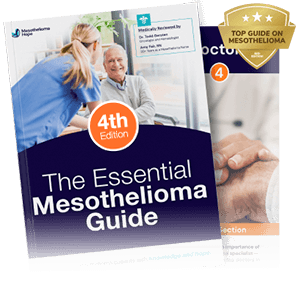Fast Facts and Statistics on Asbestos and Mesothelioma
In-depth research studies examined the effects of asbestos on workers and others contaminated by secondhand exposure. These studies revealed many alarming statistics.

Asbestos is a generic term for a group of 6 silicate minerals having similar but distinct properties. There are two main asbestos classifications — serpentine and amphibole asbestos fibers.
Chrysotile, or white asbestos, is the only serpentine fiber. Statistically, chrysotile accounts for about 90-95% of asbestos in the U.S.
The amphibole class is composed of these types of asbestos fibers:
- Actinolite
- Amosite
- Anthophyllite
- Crocidolite
- Tremolite
Amphibole fibers are more dangerous than the serpentine chrysotile class.
However, exposure to every type of asbestos places humans at risk of developing respiratory diseases like asbestosis, mesothelioma, and asbestos-related lung cancer.
Perhaps the scariest fact about asbestos is that even minimal exposure is considered dangerous.
“There is no ‘safe’ level of asbestos exposure for any type of asbestos fiber.”
– Occupational Safety and Health Administration
Overwhelming evidence supports statistics showing that the amount of exposure, the exposure duration or time length, and the specific form of asbestos had a cumulative effect on the chance a worker developed asbestos-related diseases.
These credible organizations support asbestos research:
- United States Environmental Agency (EPA)
- U.S. Occupational Safety & Health Administration (OSHA)
- U.S. Department of Labor (USDL)
- U.S. Geological Survey (USGS)
- U.S. Center for Disease Control (CDC)
- National Institute for Occupational Safety & Health (NIOSH)
- International Agency for Research in Cancer (IARC)
- International Labor Organization (ILO)
- World Health Organization (WHO)
It’s important to know that there’s no dedicated website or resource for asbestos statistics. Each government organization has credible information scattered throughout its sites.
Non-governmental agencies (NGOs) have excellent statistics as do private resources specializing in asbestos-related diseases. Most published statistics on asbestos are remarkably consistent.
Asbestos Production Statistics
Asbestos naturally occurs on every continent. It was extracted close to the surface, with 90% of raw asbestos material coming from open-pit mines. The remaining 10% came from underground mine shafts and tunnels.
Underground (or hard-rock) mines often produced asbestos as a by-product when harvesting other minerals.
Large-quantity asbestos production started in the early 1900s and ran until the 1980s. By then, overwhelming evidence linked asbestos exposure to deadly diseases.
Worldwide asbestos production peaked in 1973, with America alone extracting and processing 804,000 tons.
Over 25 different countries mined asbestos in the 70s and produced a yearly estimate of 4.8 million metric tons of asbestos ore.
Additionally, 85 countries took raw asbestos and manufactured more than 3,000 different products that contained asbestos. For example, gaskets, valves, insulation, shingles, and paint commonly contained asbestos.
The top asbestos-producing countries of the 20th century were:
- Brazil
- Canada
- China
- Cyprus
- Greece
- Italy
- Russia
- South Africa
- United States
- Zimbabwe
The U.S. was a much larger importer and consumer of raw asbestos than a miner of the mineral. However, it did not stop mining asbestos until 2002.
Environmental protection and worker safety regulations attacked the product supply chain, causing U.S. demand to drop 95% by 1990. Up until that time, America had the world’s highest demand for asbestos to make products.
In the 100-year period from 1900 to 2003, Americans mined approximately 3.29 million metric tons of asbestos ore. Conversely, the U.S. imported and processed about 31.5 million metric tons.
That worked out to a ratio of 10:1 importing over extracting asbestos from American soil.
In 2021, the U.S. consumed about 320 metric tons of chrysotile asbestos, all imported from Brazil.
Production of Asbestos Today
Worldwide asbestos demand hasn’t gone away. In fact, asbestos consumption has risen in the developing world, where countries like India and China haven’t banned asbestos products.
Russia produces more asbestos than any other country in the world.
The most recent statistics by the U.S. Geological Survey estimated world raw asbestos production at over 1.2 million metric tons (mt).
Currently, the biggest asbestos producers are:
- Russia — 700,000 mt.
- Kazakhstan — 250,000 mt.
- China — 120,000 mt.
- Brazil — 110,000 mt.
Smaller asbestos producers include Ukraine, Thailand, Iran, Mexico, Indonesia, and Vietnam.
Asbestos Health Risk Statistics
American health risk statistics from asbestos exposure appear accurate.
The Centers for Disease Control and Prevention (CDC) began tracking asbestos-related deaths and illnesses in 1999. Most of these were mesothelioma cases caused by airborne asbestos exposure.
The CDC confirmed that 18,068 American citizens had died by 2005 due to long-term asbestos exposure.
They extrapolated that the asbestos epidemic would claim 29,667 more lives from 2005 to 2027. That’s an average of 1,290 asbestos-related deaths per year in America alone.
Other alarming asbestos health statistics include:
- 27 million American workers had asbestos exposure from 1940 to 1980 when strict controls started.
- 1.3 million American workers are still exposed to workplace asbestos today.
- 2,500 to 3,000 new mesothelioma cases are diagnosed in the U.S. each year.
- 43,073 mesothelioma and asbestosis deaths occurred in America between 1979 and 2001.
Mesothelioma case numbers are expected to peak between 2016 and 2020 and then proportionately fall off.
Asbestos-related diseases will reduce in future years because the number of high-risk exposures dropped after 1980 when controls were put in place and the use of asbestos decreased.
There is also a known latency period of 10-50 years from initial exposure until a person shows symptoms of mesothelioma or another asbestos disease. That means that someone exposed to asbestos in 1978 may not discover that they have mesothelioma until 2028, when the disease is in an advanced stage.
If you or a loved one has been diagnosed with mesothelioma, our free 2023 Mesothelioma Guide has information on top treatments, financial aid, and more.
Mesothelioma and Other Disease Statistics
Malignant mesothelioma is a rare cancer that people can get when they inhale microscopic asbestos fibers.
The most alarming statistic about this disease is that most mesothelioma patients are diagnosed at stage 3 when it’s near impossible to treat. No one has survived advanced mesothelioma.
There is progress in multimodal treatment approaches, including surgery, immunotherapy, chemotherapy, and radiation.
Some statistics involving mesothelioma deaths and survival times are:
- 40% of victims live more than 1 year after diagnosis
- 20% survive 2 years
- 10% live for 3 years
- Life expectancies are grim — only 5% make it to 5 years after diagnosis
- Men are 4.6 times more likely to develop mesothelioma than women
- Women survive 3 times longer than men after diagnosis
- Men over 60 are 10 times more likely to develop mesothelioma than 40-year-olds
- The annual number of deaths among women jumped from 489 in 1999 to 614 in 2020
- Women with a husband or father working in an asbestos-related industry are 10 times more likely to develop mesothelioma
But, there is hope. A February 2024 search of clinicaltrials.gov — a database of clinical studies around the world — showed 71 active clinical trials for mesothelioma. In clinical trials, scientists are researching the latest treatments for mesothelioma and other asbestos diseases.
Some statistics on other asbestos diseases are:
- At least 30 Americans die each day from asbestos-caused illnesses
- Between 2-10% of people exposed to asbestos will develop a related disease
- Between 80-90% of asbestos diseases are a type of lung disease
An early diagnosis is the best way to improve a mesothelioma prognosis. Our free Mesothelioma Symptoms Checklist can help you record your symptoms for your next doctor’s appointment.
Occupational Exposure Statistics
As noted above, occupational asbestos exposure has led to a large number of deaths.
According to CDC data reported in May 2022, the estimated median interval from a worker’s first occupational exposure to death from malignant mesothelioma is 32 years.

Statistically, groups with the highest risk factors were workers who mined asbestos, manufactured and installed asbestos products, and worked with disturbed asbestos products by maintaining, repairing, or demolishing them.
The CDC reports that, among men, 85% of mesothelioma cases have been linked to workplace asbestos exposure. That number drops to 23% for women.
Statistics put these workers on the top 10 list for being at risk of developing asbestos-related diseases:
- Shipyard workers and on-ship employees
- Welders, foundry, and metalsmiths
- Steel mill workers
- Construction workers
- Railroad staff
- Mechanics and automotive technicians
- Oil refinery workers
- Firefighters
- Plumbers and pipefitters
- Military personnel
More than one-third of people diagnosed with mesothelioma are U.S. military veterans. All branches of the military used asbestos in some capacity for many decades.
Women in these 3 occupations had the highest number of mesothelioma deaths in 2020:
- Homemakers (22.8%)
- Elementary and middle school teachers (5.6%)
- Registered nurses (4.9%)
The CDC calculated these numbers using information reported on death certificates.
OSHA Asbestos Standards
OSHA sets acceptable asbestos exposure standards. Currently, the permissible exposure limit (PEL) is 0.1 asbestos fibers per cubic centimeter of air.
That’s rated as 0.1f/cc. Originally, OSHA had a 12.0 f/cc PEL when it first established a baseline in 1971.
The agency dropped it to 5.0 f/cc in 1972, then to 2.0 f/cc in 1976, and lowered it again in 1986 to 0.2 f/cc before setting it at 01 f/cc in 1994.
Historic inspection data reveals some shocking f/cc stats:
- High-risk areas like ship engine rooms had a constant f/cc count of over 100
- Immediate and sudden asbestos exposures like removing car brake drums could be 100,000 f/cc
- Even 1.0 f/cc posed an extreme risk to workers
- 20% of all air at construction sites far exceeded the OSHA PEL
- Almost every worksite had areas where asbestos f/cc counts exceeded acceptable levels
Compensation for Mesothelioma Victims
One final asbestos statistic is that many mesothelioma victims have collected large compensation payments from negligent asbestos manufacturers and suppliers.
Compensation is available to pay for medical expenses, lost income, and personal injury damages.
Families can claim on behalf of members with asbestos-related illnesses. They can also file lawsuits in wrongful death cases.
Contact our Patient Advocates today to learn whether you or a loved one may qualify for compensation.
Asbestos Statistics FAQs
How many deaths are caused by asbestos?
On average, 1,290 asbestos deaths occur every year in the U.S., according to data from the Centers for Disease Control and Prevention.
The World Health Organization says more than 90,000 people around the globe die every year from asbestos-related diseases like mesothelioma.
How many people are exposed to asbestos?
About 1.3 million Americans are exposed to asbestos connected to their workplace today.
Many of these workers are in the construction industry.
Who is exposed to asbestos the most?
In general, people exposed to asbestos the most have jobs that cause them to work with or around asbestos or asbestos products. This includes construction workers, mechanics and auto technicians, and asbestos abatement specialists.
Even though most asbestos products have been banned in the U.S. for decades, many asbestos-laden products can still be found in old homes and buildings. This is known as legacy asbestos.
Additionally, some auto parts still contain a small amount of asbestos.
Historically, U.S. military veterans have had extremely high rates of asbestos exposure. All military branches used asbestos in vehicles, barracks, or some other capacity.





